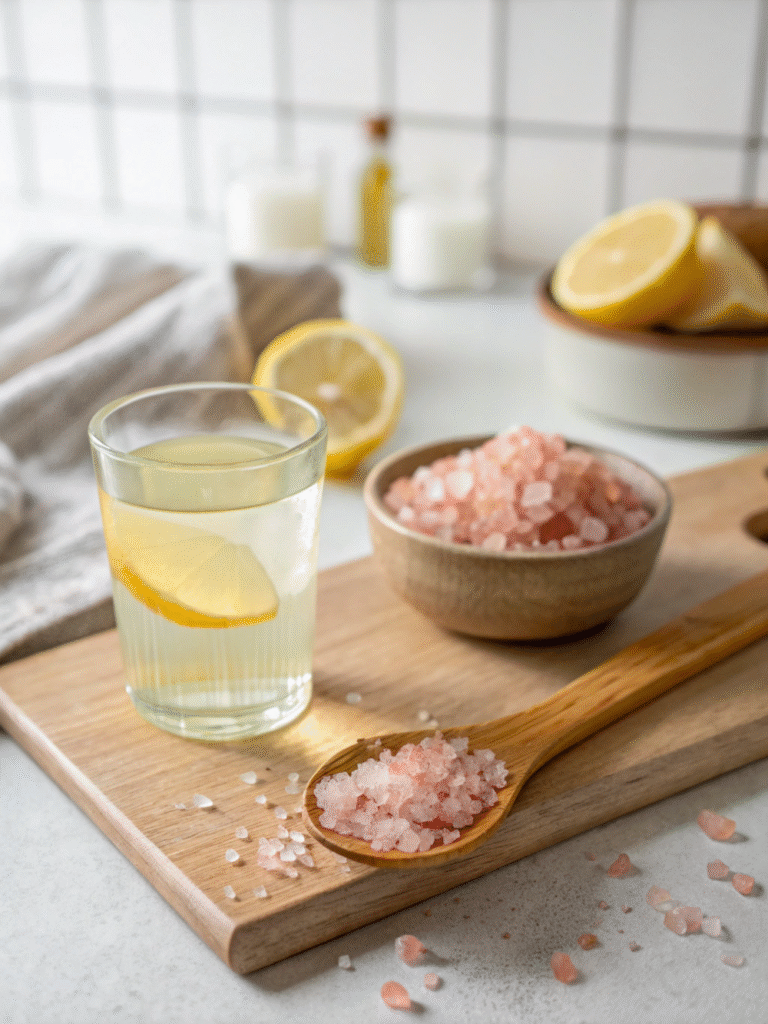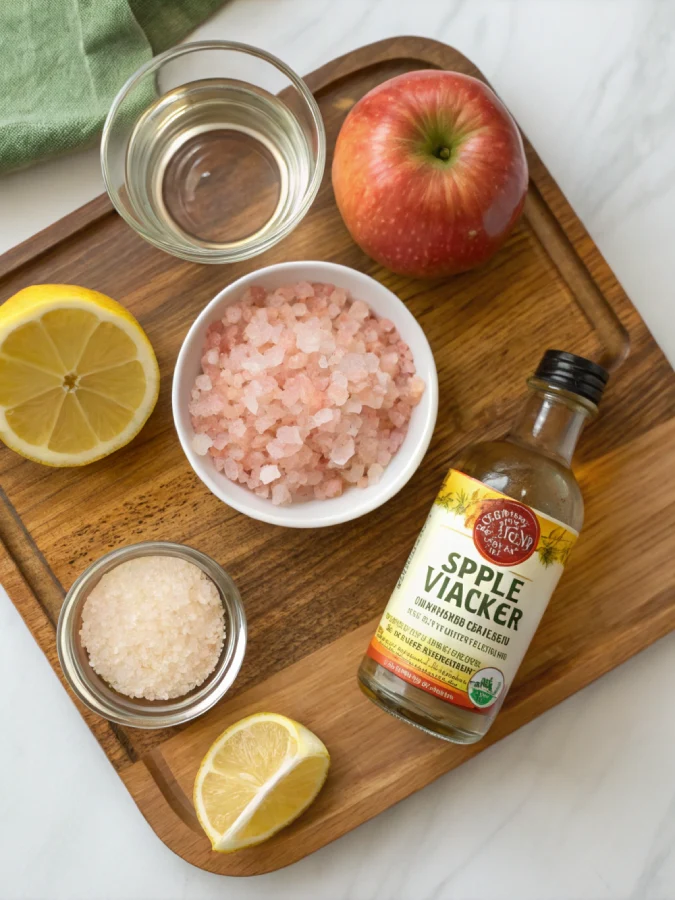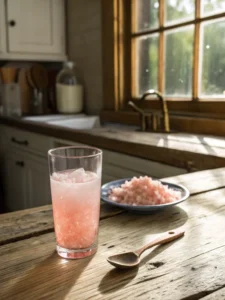
If you’ve been scrolling through TikTok or health blogs lately, you’ve probably heard about the Japanese pink salt recipe. People swear it’s a “miracle” for weight loss, digestion, and energy, but what’s the truth behind the trend? As a chef who’s cooked for comfort and wellness, I had to test this myself.
This article dives deep into the Japanese pink salt trick, how it differs from Himalayan salt blends, what recipes are trending (with science-backed ingredients), and whether this so-called detox trick holds up. You’ll also find variations, prep tips, and my take on the 4-ingredient version that’s gone viral.
Let’s start at the beginning, with a very personal reason why I was curious about this recipe in the first place.
Table of Contents
The Truth About Japanese Pink Salt
A Family Detox That Sparked My Curiosity
A few months back, my sister was dealing with bloating and sluggish mornings. Nothing dramatic, just that feeling like your body isn’t quite firing on all cylinders. That’s when she sent me a link titled “Japanese pink salt recipe for weight loss”. I rolled my eyes (as a chef does with viral fads), but out of curiosity, and let’s be real, love, I dug into the ingredients.
Turns out, the original “Japanese” versions circulating the web often mix pink salt (Himalayan or sea salt) with lemon, warm water, and occasionally apple cider vinegar. A few sources like EatWellWell’s own pink salt breakdown confirmed this isn’t some new-age scam, it’s an adaptation of long-standing Eastern detox practices, simplified for modern routines.
We tried it as a family ritual for five days, just a warm glass each morning. No magic weight drop, but guess what? Digestion improved. And that 3 PM slump? Gone.
What Is Japanese Pink Salt Recipe?
Despite the name, most Japanese pink salt recipes don’t actually originate in Japan. Instead, they’re inspired by Japanese wellness philosophies, which emphasize balance, minimalism, and gut-friendly ingredients.
Here’s the most common version:
| Ingredient | Function |
|---|---|
| 1/4 tsp Pink Himalayan Salt | Mineral-rich electrolyte booster |
| 1 tbsp Lemon Juice | Alkalizing & digestive aid |
| 8 oz Warm Water | Hydration & absorption |
| Optional: 1 tsp Apple Cider Vinegar | Supports metabolism |
When taken first thing in the morning, it may help reset digestion, stimulate stomach acid, and hydrate cells.
According to MedlinePlus, hydration combined with electrolytes can improve energy, mental clarity, and blood sugar balance, a subtle but important support for any weight-loss journey.
You’ll find popular variations of this recipe in several trending guides like EatWellWell’s pink salt weight loss recipe or their pink salt detox version which explores different combos.

Japanese Pink Salt Recipe
Ingredients
Equipment
Method
- Add pink Himalayan salt to the glass of water.
- Stir in lemon juice and apple cider vinegar (if using).
- Sip slowly first thing in the morning on an empty stomach.
Notes
The 4-Ingredient Pink Salt Trick: Real Results or Just Hype?

What Is the 4-Ingredient Pink Salt Trick?
This version is making waves on TikTok and wellness blogs alike. It’s being called “The Japanese Pink Salt Trick” for its simplicity, and its supposed ability to help people shed stubborn belly weight. The idea? Combine four pantry-friendly ingredients to kickstart metabolism, reduce cravings, and flush out water weight.
Here’s the viral recipe:
| Ingredient | Why It’s Included |
|---|---|
| 1/4 tsp Japanese Pink Salt (or Himalayan) | Provides minerals & balances hydration |
| 1 tbsp Apple Cider Vinegar | May aid blood sugar & appetite regulation |
| 1 tbsp Lemon Juice | Alkalizing and anti-inflammatory |
| 8 oz Warm Water | Delivers everything gently to the system |
Some people add a pinch of cayenne for a thermogenic boost, but that’s optional.
This recipe has been featured across wellness platforms like EatWellWell’s trick recipe and further broken down in this take on whether it’s real or a scam.
The preparation couldn’t be easier: mix everything in a glass, sip slowly in the morning before eating. Drink daily for 7–10 days max, then pause.
What Is the Pink Salt Trick for Weight Loss?
Despite the buzzword-heavy claims, there is some logic to this routine. Let’s unpack how it might support weight loss, without pretending it’s a miracle cure.
- Hydration with electrolytes helps reduce bloating and improves energy balance.
- Apple cider vinegar, supported by NIH research, may help regulate blood glucose and curb appetite.
- Lemon juice contains polyphenols that support digestion and may reduce fat accumulation over time.
This isn’t a weight-loss pill or gimmick. It’s a gentle, daily practice that supports natural rhythms: flushing excess water, priming digestion, and encouraging mindful mornings.
On EatWellWell’s pink salt weight loss page, many readers say they felt lighter and less puffy after just a few days. That’s not fat loss, it’s inflammation and fluid regulation. But it’s real, and it feels good.
Keep in mind: sustainable weight loss always comes down to calorie balance, movement, and sleep. But as a daily wellness support? This trick has a place, especially if you’re looking for something simple and effective to build momentum.
Japanese Pink Salt vs Himalayan Salt – What’s the Real Deal?
Is Japanese Pink Salt the Same as Himalayan Salt?
If you’ve searched for a Japanese pink salt recipe, you might’ve been surprised to find… there’s actually no pink salt mined in Japan. That’s right. Most “Japanese” pink salt blends use Himalayan pink salt, a mineral-rich rock salt sourced from the Khewra mines in Pakistan.
So why call it Japanese?
It’s more about the recipe style than the salt’s origin. These pink salt blends are inspired by Japanese traditions of clean, morning hydration and the Japanese principle of shokuyo, which views food as medicine. When used in warm detox drinks, it mirrors Eastern wellness practices, even if the salt itself is Himalayan.
Let’s compare the two:
| Salt Type | Source | Minerals |
|---|---|---|
| Japanese Pink Salt (recipe blend) | Not mined—Himalayan salt used in Japanese-inspired recipes | 84 trace minerals, including magnesium and potassium |
| Himalayan Pink Salt | Pakistan (Khewra Salt Mine) | Same, unrefined mineral profile |
In short: they’re the same salt, but the japanese pink salt recipe refers to how it’s used—not where it’s from.
If you’re looking for trustworthy pink salt, choose fine-ground, non-iodized Himalayan salt, like this USDA-recommended nutrition facts on sodium intake, and make sure it’s lab-tested for purity.
EatWellWell’s breakdown on whether the pink salt trick is a scam also highlights the confusion—and clears up the myths.
What Makes This Recipe Unique?
Most detox drinks use lemon, ACV, and cayenne. What sets this apart is the balance of flavor, minerals, and the Japanese morning ritual vibe. It’s about slowness, not stress. Sipping it before the morning chaos hits resets not just your body, but your mindset.
When you adopt the japanese pink salt recipe as a morning habit, you’re choosing intentionality. That alone shifts your relationship to health and food.
You’ll also find variants on EatWellWell like the pink salt diet recipe or the what-is version for new beginners trying it for the first time.
How to Use the Japanese Pink Salt Recipe Safely

How Often Should You Drink the Japanese Pink Salt Recipe?
Once a day is enough.
The Japanese pink salt recipe works best when consumed in the morning on an empty stomach, preferably 15–20 minutes before breakfast. This timing supports digestion, stimulates stomach acid, and helps your body absorb minerals more effectively.
According to wellness experts and dietitians, consistent use for 7–10 days followed by a 2–3 day break is a safe rhythm. It’s not about long-term dependency. Think of it as a reset tool, especially after travel, overeating, or low-energy weeks.
Here’s a simple weekly guideline:
| Day | Action |
|---|---|
| Monday–Friday | Drink one glass of the Japanese pink salt recipe |
| Saturday–Sunday | Rest days or switch to lemon water only |
Make sure to hydrate throughout the day, since salt-based drinks can cause slight water loss in the early hours. You can find this protocol echoed in other weight-focused recipes like EatWellWell’s pink salt recipe for weight loss.
Who Should Avoid the Pink Salt Trick?
This part is important.
If you have any salt-sensitive conditions, like high blood pressure, kidney issues, or you’re on diuretics, skip this recipe or consult your doctor first.
Even though pink salt contains less sodium than table salt, it’s still salt. According to the CDC’s sodium guidelines, most adults already exceed the daily sodium limit, so moderation is key.
Also, if you’re fasting or following keto, this recipe may actually help reduce symptoms like dizziness or fatigue. But again, listen to your body.
People with GERD may want to omit apple cider vinegar. Instead, stick with just pink salt, lemon, and warm water, the more soothing combo.
For further modifications and flavor tweaks, check EatWellWell’s pink salt trick variations and apple cider vinegar combinations.
When used wisely, the japanese pink salt recipe is a safe, affordable, and functional ritual. But like any habit, it should enhance your day, not stress your system.
Frequently Asked Questions
What Is Japanese Pink Salt Recipe?
The Japanese pink salt recipe is a warm morning detox drink made from pink Himalayan salt, lemon juice, water, and sometimes apple cider vinegar. It’s inspired by Japanese wellness habits but uses non-Japanese ingredients in a balanced, functional way to support hydration, digestion, and weight loss. You can find different versions of the recipe on sites like EatWellWell, where it’s tailored to energy and gut health.
What is the 4-ingredient pink salt trick?
It refers to a viral version of the japanese pink salt recipe that includes pink salt, lemon juice, warm water, and apple cider vinegar. It’s used to promote better digestion and possibly help reduce bloating or cravings. The ingredients work together to replenish minerals, support metabolism, and start your day with a mindful routine.
What is the Japanese pink salt trick?
The “trick” is simply using a Japanese pink salt recipe as a morning tonic. By combining detox-friendly ingredients with warm water, this simple recipe helps flush out your system and gently boost energy. Though not rooted in traditional Japanese cuisine, it mirrors their emphasis on balance and morning hydration.
What is the pink salt trick for weight loss recipe?
This is a targeted variation of the japanese pink salt recipe aimed at helping you start the day light and energized. It’s most often used first thing in the morning before food, and has gained traction among those practicing intermittent fasting or clean eating routines. Recipes like this one on EatWellWell include specific timing and usage guidelines.
Does the pink salt trick actually work?
Anecdotally, yes, but it’s not a miracle drink. The japanese pink salt recipe helps many people feel less bloated, more hydrated, and energized in the morning. It doesn’t melt fat, but it can support metabolism and reduce poor eating choices by starting your day with intention. Read this review to explore what’s real and what’s just hype.
Is Japanese pink salt the same as Himalayan salt?
Technically, yes. Recipes marketed as japanese pink salt recipes almost always use Himalayan pink salt. The “Japanese” label refers more to the wellness style and minimalist approach, not the geographic origin of the salt.
Conclusion: Is the Japanese Pink Salt Recipe Worth Trying?
If you’re tired of fads that overpromise and underdeliver, the japanese pink salt recipe is a refreshing shift. It doesn’t rely on powders, pills, or expensive ingredients, just warm water, lemon, pink salt, and intention.
Whether you’re looking to support weight loss, improve digestion, or start your day more mindfully, this ritual is simple, safe, and affordable. It takes less than 5 minutes to make, and can change how your whole morning feels.
From personal experience and tons of research across EatWellWell’s pink salt content, from the basic recipe to weight-loss versions, this isn’t about hype. It’s about real habits that work.
So go ahead. Mix your first glass tomorrow morning. Sip slow. You might be surprised by how powerful simple can feel.



